( – promoted by buhdydharma )
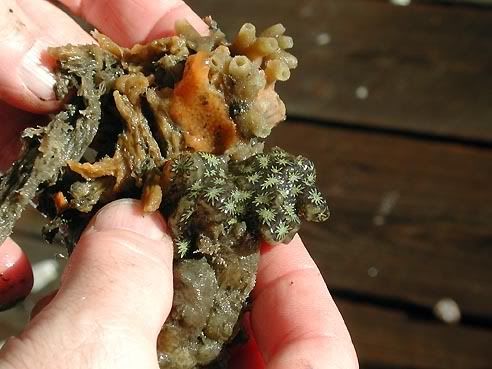
Invasive Species Photo by K. Borden | Senator Boxer is fighting to protect US waters from invasive species that spread deadly diseases to people and wildlife, impair water supply infrastructure, harm ecosystems, cause twice the annual economic damage of all natural disasters, and are linked to half of the decline of endangered species. When large ships are not transporting cargo, the ships pump coastal waters and all the living organisms into their ballast tanks while at foreign ports to obtain balance. When closer to our shores, the ballast water is exchanged with ocean waters, but the exchange does not eliminate the invasive species, which then are discharged into our waters. The 9th Circuit has directed the EPA to regulate this pollution while Congress has reached an impasse on legislation. |
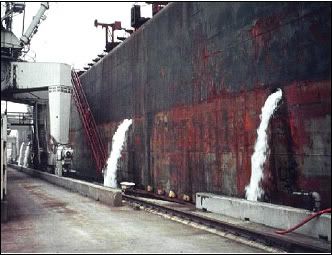
Discharging ballast water at port EPA photo | Ballast water is needed to provide balance for changes in the ship’s weight. The problem is that the ballast water contains thousands of invasive species which are then carried in the ballast tanks of the ship. When a ship reaches the next port, changes in the cargo load may require changes in ballast, and thus the ballast water is discharged into a new ecosystem. When the ships return to the US, then the invasive critters are released into US waters. Each year, “more than 21 billion gallons of ballast water” is discharged into US waters. |
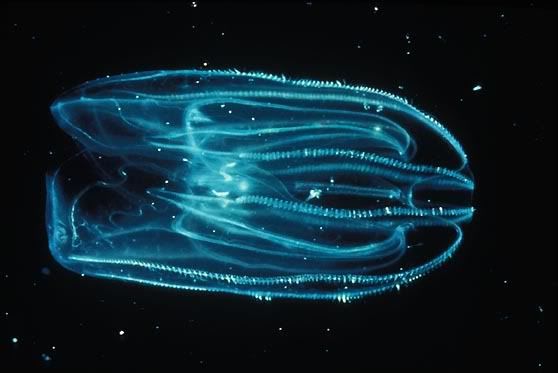
Mnemiopsis leidyi Photo by JT Carlton | The invasive species range from “microscopic bacteria to weeds, fish, crabs and mussels.” Each day, more than 10,000 marine species “hitch rides around the globe in the ballast water of cargo ships.” |
These invasive species then create enormous problems for our water supplies, environment and people.
They can spread disease. A 2001 EPA report disclosed that a cholera bacteria was “possibly” released by a Chinese freighter in Latin America, which caused the deaths of 10,000 people. Ships from Latin America then imported this cholera in their ballast tanks to the Mobile, Alabama port. Fortunately, the cholera bacteria was discovered in oyster and finfish samples so that no one was killed in the US.
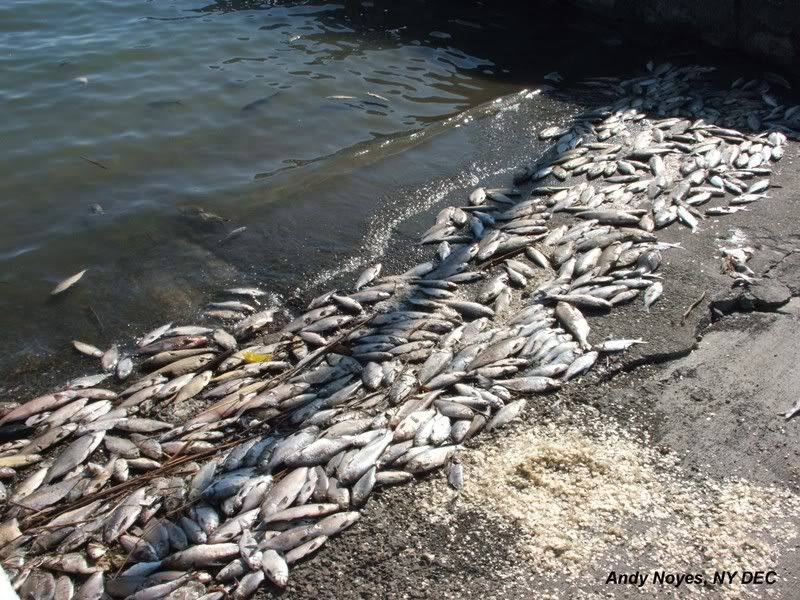
Source: South Dakota Game, Fish and Parks | Deadly diseases are spread to wildlife as well as people. For example, Viral Hemorrhagic Septicemia (VHS) is an invasive species virus transported to the US either by migrating fish or ship ballast water. The fish rapidly die from bleeding. |
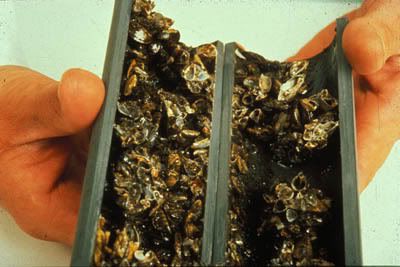
Zebra Mussels in pipe Photo by JT Carlton | They clog the water pipes and infrastructure. For example, two decades ago, little quagga and zebra mussels hitched a ride from Eastern Europe to the Great Lakes. In 6 years, the invasive species caused $500 million in damages to the regional economy by clogging water intake pipes. Last year, the mussels spread to Lake Mead in Nevada and on to Southern California, where one water district projects it will cost at least $15 million a year to try to extinguish aqueduct infestations. |
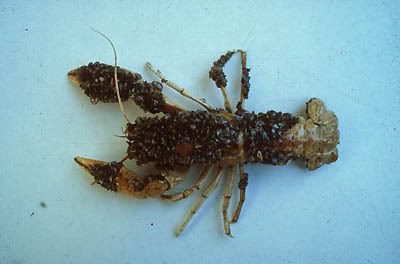
Zebra mussels on crayfish Photo by JT Carlton | They threaten native species: Invasive species are a “major or contributing cause of declines for almost half the endangered species” in the US. The absence of natural predators allows the invasive species to “multiply rapidly and quickly take over an ecosystem.” |
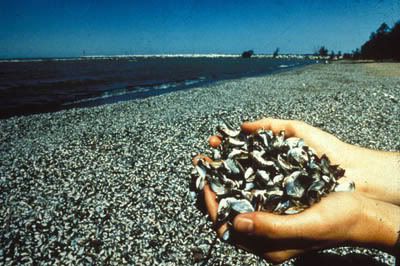
Zebra mussels on beach Photo by JT Carlton | The threat by invasive species is enhanced because they are “almost impossible to remove” and thus scientists, industry officials and land managers have concluded that “invasive species are one of the most serious, yet least appreciated, environmental threats of the 21st century.” |

Fouling on vessel propeller Photo by L. Takata | Finally, the invasive species create an enormous economic loss that is “double the annual economic damage caused by all natural disasters in the United States.” Our government spends millions of dollars each year to detect and prevent invasive species from entering the US. The General Accounting Office cited one study which calculated economic losses at $137 billion a year. |
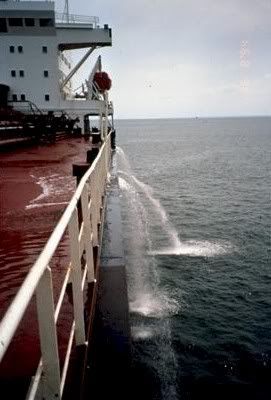
Mid-ocean ballast water exchange National Ballast Information Clearinghouse | The current US method to rid ballast water of invasive species is to use ballast water exchanges 200 miles offshore where coastal waters are replaced with open-ocean waters. It is supposed to eliminate invasive species, but many simply sink to the bottom of the ballast tank. The theory is that oceanic organisms may have a “lower probability of survival in nearshore waters.” However, the scientific perspective is that ballast exchanges are not effective. In fact, the Great Lakes have used ballast water exchanges for 20 years, but are still hit by new invasions every 28 weeks. |
All of these harms should never have happened. The Clean Water Act (CWA) mandates that the discharge of any pollutants into US waters is unlawful unless authorized by a permit. Pollutant is defined to include “biological materials,” which is defined to include invasive species. However, the EPA issued a regulation in 1973 that exempted ballast water from the regulatory permitting requirements.
Last month, the 9th Circuit held that the EPA must regulate ballast water discharges under the CWA. While the EPA is mulling over how to comply with the court decision, Congress is also considering invasive species legislation.
Last April, the House passed a bill that would for the “first time” mandate oceangoing ships to install ballast water treatment facilities by 2015 that would be capable of removing “all living organisms from ballast water.” However, the shipping industry assisted drafting this bill, which may provide “immunity” to the shipping industry from CWA lawsuits and may preempt states from imposing higher standards to protect their waters.
In the Senate, Sen. Boxer and Sen. Inouye disagree on the same issues of immunity and preemption. Sen. Boxer is blocking Sen. Inouye’s bill, which favors a “single national standard” that would bar state regulation. Moreover, Sen. Inouye wants the Coast Guard to continue managing the program while Sen. Boxer wants the program partially governed by the CWA, which means that environmental groups would have the right to sue to enforce the law. This is really key because oftentimes it is only environmental groups which challenge bad environmental policies, including the lawsuit that reached the 9th Circuit.

3 comments
Author
My new shorter diary format. 🙂
Author
thanks for fp bud!
I’m so proud of my california dem! (thank god, cause my other senator is bummer)